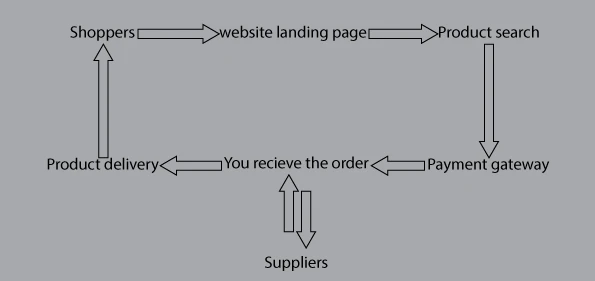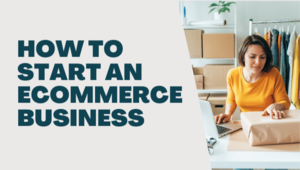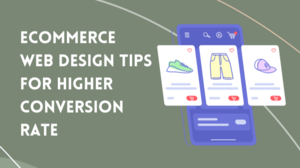How to Sell Groceries Online A Step-by-Step Guide
Are you looking to level up your brick and mortar grocery store with an ecommerce website? Do the underlying uncertainties intimidate you? If they do, then stick around, we have a few things in store. We will walk you through a step-by-step guide on selling groceries online ‘successfully’.
From setting up your business model to optimising the user interface, we got it all covered. By the end of this article, not only will you be able to make a seamless integration, but you will also be able to modify individual elements for satisfying diverse customer expectations.
Some of us might be sceptical of selling groceries online as physical storefronts have proven successful in various contexts. Shedding light on some useful numbers can put us at ease.
According to Statista, ecommerce revenue in Australia, for food and personal care items alone, is projected to reach a staggering $7,144 million by the end of 2020.
In 2019, the number was $5,479 million. With an almost 30% annual increase, we can observe a surge in favour of online shopping. Moreover, ecommerce shoppers in Australia increase by a million (approximately) every year. If the trend sustains, the number could amount to almost 21 million by 2025.
In addition, by 2025, about one-third of all sales will be done online. The market is already there; you only need to tap into it. The average Aussie visits the supermarket almost 3 times a week. If you can substitute even one of those visits with your ecommerce grocery store, the potential can be huge.
Having all that out of the way, let us get into the technical stuff.
Online grocery business model
Suppose you make an ecommerce website for your company ‘X’. Once the shoppers land on your website, they will search for their desired products. Having found something they want, they will proceed with the order. As soon as they make the payment, you will be responsible for providing the products either from your existing inventory or from your respective suppliers.
Finally, you will deliver the products to the customers’ doorsteps. Considering these key contact points, your online business model should look something like this:

The business model relies on your offline operations for the successful delivery of products. The process is also cyclic. The quality of service and the products themselves determine if the customers will return for recurring purchases.
Setting up your website
Setting up your ecommerce website is one of the essential steps for running your online grocery successfully. There are some fundamental requirements, like choosing a domain, creating a landing page, and setting up payment options along with other secondary requirements. We will be covering the whole spectrum in this section.
Choosing a domain name
A domain name is an online identity for your business. If you want to stand out and make an impact, choosing a proper domain name is crucial. A strong domain name provides visibility, pushes the site up in search engine rankings and most importantly, provides a substantial online presence.
Domain name communicates what your company stands for. Hence, it is best to choose a name replicating that of your business. Educating yourself on different types and styles of domain names can help in that endeavour.
Domain names should be short and precise. Longer names open up possibilities for typos, which might take your shoppers to other sites. Hyphens and numbers should also be excluded to minimising such instances.
Most common domain extensions include .com, .org and .net. Extensions like these come with certain conditions. For example, .org is only provided to non-profit organisations, whereas; .biz is reserved for credentialed businesses. You can either choose from them or get creative with extensions like .store, .shop, .shopping etc. You can also buy premium domains to suit your needs better. This might cost you at first but will pay off in the long run.
Choosing the right domain hosting company is also essential. Top domain hosting companies include GoDaddy, Bluehost, Hostgator, Squarespace, and Domain.com. Having a good host will potentially reduce loading times, interruptions, and high traffic issues on your website. However, managing your hosting might be a time-consuming task. You can take help from ecommerce solution providers to take care of your domain and hosting for you.
Designing your website landing page
Landing pages refer to the web pages on which visitors land after clicking a corresponding link. The first impression is always important. For that reason, landing pages should be clean, precise and intriguing.
You should include striking images and communicate some of your USP’s like super fast delivery or customised order services. If your grocery store serves only a handful of areas, the customers should be prompted to select the area they live in.
This will work as a screening process. If you are offering discounts or any other bonuses, you should advertise them as well. For added credibility, you can also include customer review scores. Anything that could reinforce the value of your offerings should be used.
There should always be a call to action (CTA) button on your landing page. This will take the visitors through the purchasing process and can eventually convert them into paying customers.
Optimising the search functionality
The importance of a well-optimised search functionality cannot be stressed enough, especially when you are looking to convert your visitors into paying customers. Your site’s search feature should be able to do more than just returning results.
Begin by using a colour that pops. Easily locatable search boxes add to the convenience of shoppers. Putting a greyed out text inside the box like “Enter the name of an item, e.g. eggs”, helps visitors understand what is expected. Make the process simple.
Make the results filterable. Visitors should be allowed to sort items based on price, popularity, quality, discounts and any other parameter you can conjure up. They should also be able to exclude items having certain features. For example, if a shopper is on a budget, he or she might be confined to a specific price range. Anything exceeding that price range will not have enough appeal, hence should be filtered out.
You should also be aware of the flexibility you offer in filtering out searches. If visitors have to initiate the searching process repeatedly, they might find it cumbersome. To address this problem, include checkboxes that will help them refine their search results repeatedly without redoing the process.
Some visitors might have specific requirements. Hence, the provision for long-tail semantic searches should be available. For example, someone searches for “Brand A honey 250 mil” and does not find the related products. They are more likely to abandon the checkout.
Research suggests, sites having a semantic-based search engine has a mere 2% abandonment rate, whereas sites that rely on plain text search can have an abandonment rate up to 40%.
Include autocomplete features. When visitors type in the initials of their desired products, a drop-down list matching the initials can help them visualise the products. As a grocery store, you are likely to have numerous products under the same category. Autocomplete search options help to simplify the process. Moreover, sites with autocomplete features are six times more likely to convert visitors in comparison to sites that do not have this feature.
Organising your product page
Product pages can make or break deals. Including a clear photo of the product without distracting watermarks is essential. A white backdrop is highly recommended if you want to keep the product in focus.
A well-structured product description provides all the necessary details in a digestible format. When shopping online, customers are not able to read the ingredients on the packaging. A product description can be used to disseminate that information.
Highlight the prices. When grocery shopping, shoppers are usually on a budget. Highlighting the prices help them speculate the total value as they keep on adding products to the cart. If you are offering promotional discounts, emphasising that with highlights is always a good idea.
Proper Call To Action buttons is essential for effective product pages. “Add to cart” and “buy now” are two of the most common CTA’s used around e-commerce websites. Whichever ones you decide to include, make sure that they have proper descriptions and are working as intended.
Designing your cart
When designing your shopping cart, mimicking the in-store experience can take you a long way. Convenience is the key. For this, you might want to include functional product images along with the ordered quantity, unit price and the total of the products included in the cart.
If you are offering express delivery, for an extra charge, you should include that. Applicable coupon and discount options should also be there.
It is important to note that any grey areas that might inconvenience the customers at checkout will increase the chances of abandonment. Therefore, any additional charges or discounts should be clearly visible before the shopper proceeds with the payment.
Some shoppers might also prefer having third party solutions for managing their finances. You should include provisions so that shoppers can integrate services like QuickBooks, Fresh books, wave accounting etc.
Integrating payment options
As a grocery store, you should have a plethora of payment options available to your shoppers. The more options you offer, the greater is the number of customers you can convert.
Debit and credit cards are the most popular methods of online payment. Some shoppers also prefer using E-wallets like PayPal and Payoneer. Adding provisions for cryptocurrency can also be intriguing for some.
In most cases, shoppers will prefer cash on delivery. Providing this option instils a sense of trust among the shoppers and can increase sales, as the shoppers can examine the products, before making payment physically. Moreover, when shoppers have more control over the buying process, perceived satisfaction is increased.
Integrating loyalty programs
Customers always like to receive rewards for their purchases. However, giving out free stuff does not seem to cut it anymore. The rewards should be tailored to what customers want. They can be customised experiences, digital content or even sweepstake.
You can offer cash or gift cards for the customers to spend on anything they desire. You can also provide bundle offers at significant discounts to your loyal shoppers.
The loyalty program should be simple and redeeming mechanisms should be easily understandable. Complicated requirements like “if you purchase ‘x’ in the next 24 hours, you will get ‘y’ at a 10% discount” will be a deal-breaker for most.
User-generated reviews
User reviews give your business credibility. 95% of shoppers consult user reviews before purchase. Having a dedicated user review section communicates transparency. Moreover, about 50% of the shoppers will only purchase products that have four or more stars on a 5-star scale.
The user review section should have provisions for descriptions, photos and a rating system for the services received. The rating system helps to determine the overall efficacy of your online grocery business, whereas the narratives shed light upon the details.
Live chat support
The live chat support should show that you care about the customers. Using a Chatbot can help to answer common questions, but diverse customers have varying queries. For that, you will need to have a dedicated customer service team.
Adding in a support rating system can also help to weed out inconsistencies, refining the services in the process. Moreover, this will help you in acquiring information on customer experiences and services.
Having a ticket system can also help shoppers to make requests and place queries that might not need addressing right away. It will also help you to market products to these customers through their emails.
There should also be a database for frequently asked questions. Customers facing everyday problems can consult those at their convenience.
Optimising your website for mobile platforms
While designing your ecommerce website, keep in mind, that more than 50% of the global web traffic is generated from mobile platforms. If your website acts weird on mobile devices, you are losing a significant number of customers almost instantaneously.
Make sure that your website is backed up with clean code and has a credible domain host to reduce lags or server responsiveness issues. If you are using templates, do not make the site too crowded with unnecessary elements. Try to keep it simple.
SEO optimisation
Primarily you will need to conduct some keyword research and use the acquired knowledge to determine the site’s architecture. You can use these keywords to produce contents that could highlight your presence to internet users.
In addition to content marketing, you can also focus on link building and local SEO strategies to reach out to customers from your brick and mortar store. Doing some competitor research can also help your business stand out. Use Google Analytics to monitor your SEO performance and make modifications as you go.
Developing a mobile app for your online grocery business
Once your grocery ecommerce website takes off, you have to focus on facilitating a seamless customer experience. Developing a mobile application can address many problems at once. In this segment, we will cover the ins and outs of developing a mobile app for your online grocery store.
Useful ecommerce apps need to have an optimised User Interface for the convenience of shoppers. To begin with, they should have an easy login/ registration solution. Shoppers should be able to log in using their social media credentials or integrated emails. Putting them through a lengthy registration process can reduce the chances of locking in sales.
They should have a user-friendly faceted search feature that helps users to zero in on their desired products without much effort. The search results should also be optimised so that users can navigate through them without much hassle.
A product comparison feature can also add value to the process. Having a practical overview of the different offerings can help customers make informed choices, which is always good for business. You can also include real-time analytics; to show potential customers how many times a product has been bought in the last couple of weeks or months.
Aside from creating urgency, this step will help customers determine mass preference and assess an items perceived value. Adding an order tracking option with real-time feedback can put shoppers at ease. They will feel secured and more in control.
You can also get creative by adding features like shopping list reminders and automated shopping assistance. If your shoppers want to save themselves from the hassle of browsing and selecting products, they can enter their budget and list the products they need. The app can automatically select the products, optimise them within the budget and take your shopper directly to check out.
If you are relying on third party operators for delivering the products to customers’ doorsteps, then you might as well develop an app for that purpose. The delivery boy should be able to register quickly. Managing orders, profiles and wallets should be seamless. A geo-location tracking system should be integrated with that of the customers’ app. Also, a well-documented delivery and earning history can help in measuring progress and challenges.
Marketing strategy for your online grocery business
Running a business is not confined to making profits; it also requires growth. Even if your online grocery business is working and bringing in a significant amount of revenue, without proper marketing, you will experience an inhibiting ceiling. In this segment, we will cover some of the most effective marketing strategies for your online grocery business.
Social media marketing
Popular social media platforms offer targeted marketing opportunities. You are not confined to mere demographics anymore. Instead, you can access customers who have shown interest in a particular product in the last month or week. The degree of accuracy offered by these platforms is unparalleled.
Set up a page and post unique contents that highlight your U.S.P. Use vibrant colours and clean images to disseminate value offerings.
Influencer marketing
Influencer marketing gives you access to thousands of potential customers, almost instantaneously. Public figures having a massive fan following on social platforms are ideal for this approach. Moreover, you do not have to work hard for earning their trust, as they trust the influencer you have chosen to endorse your business.
Email and SMS marketing
Once a shopper completes a transaction with your business, you can ask for his/her email for sending regular updates. You can send weekly promotional offers to thousands of customers with the click of a button.
The same goes for SMS marketing. Along with that, you can establish a referral program, which will generate rewards.
Retargeting tactics work best when you keep a clear database of customer purchase history. Based on the purchasing trends, a few strategic words can convert into sales.
Wish list reminder
Customers often register products sin wish lists due to unavailability, shortage of budget, or maybe they are waiting for a discount. Do not let these interests go unnoticed. Maintain a database and send relevant updates on the products to the respective customers.
Offer a money-back guarantee
Offer a money-back guarantee for customers who do not receive what they ordered or if the products lack the promised quality. Along with securing sales, and you will be able to ensure a level of trust that would greatly benefit your business. You will also need to have a strict quality control mechanism to minimise such instances.
Answer customer queries publicly
If an aggrieved customer registers a complaint, address it as soon as possible. Be swift and precise to minimise collateral damage. Addressing these problems publicly instils a greater sense of security as potential shoppers often make purchasing decisions based on your active involvement.
By now, you have gone through all the essential steps needed for selling groceries online. Everything boils down to knowing your customers. With the technical knowledge and a bit of luck, your business success story is just a few clicks away.








